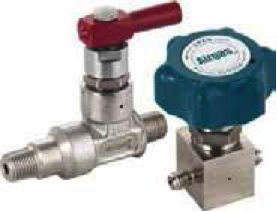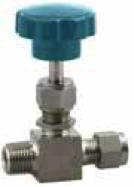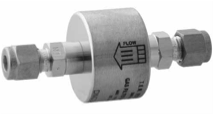
This is the second part of our article, Maintaining Gas Stream Purity, from the previous edition of Clean Peaks. We will continue by discussing various components of the gas delivery system, configuration and leak testing. Armed with this information, you should be able to create greater consistencies in your analytical applications, peak to peak and sample to sample.
 A critical component in any gas system, valves are used to shut off the gas flow, isolate a part of the system or-in the case of an excess flow valve or safety relief valve-protect the system, personnel or the process. The construction of valves and whether or not they use lubricants can have a major impact on gas purity, so to avoid gas stream contamination, it is critical to know if a valve uses lubricants, and if so, what kinds.
A critical component in any gas system, valves are used to shut off the gas flow, isolate a part of the system or-in the case of an excess flow valve or safety relief valve-protect the system, personnel or the process. The construction of valves and whether or not they use lubricants can have a major impact on gas purity, so to avoid gas stream contamination, it is critical to know if a valve uses lubricants, and if so, what kinds.
Please refer to our Chromatographer's Guide to Gases and Gas Delivery Systems for more information and how to select the correct type.
Today we have better approaches to cylinder mounting to make the change-out process easier and more efficient. One approach is to have all regulators mounted to a wall or a bench with a flexible pigtail to the cylinder.
Check valves make sure the gas only travels in one direction regardless of how many lines are connected. They can have lubricants to help them seal, so you must ensure the lubricant is non hydrocarbon- or halocarbon-based.
Whenever a flammable gas like hydrogen is used, there is a possible flashback to the gas supply source, potentially resulting in explosion. Luckily, using a flash arrestor is a good safety measure.
Apart from being just recommended, flash arrestors are actually mandatory in some cases. Code requires that a flash arrestor be incorporated when the gas is being used as a fuel. And although it’s not code in this instance, whenever hydrogen is used as a carrier gas and the detector is an FID, a flash arrestor should definitely be part of the system.
Just adding a flash arrestor in your system, however, isn’t quite enough. It is extremely important to know the flash arrestor is cleaned correctly and that its material components are compatible with the gas purity, so choose carefully.
As always, only incorporate high-purity excess flow valves that are non-lubricated. For detailed information about EFVs, please refer to this article from a previous edition of Clean Peaks.
There are three types of shut-off valves you can use in an analytical gas delivery system: Ball valves, packless diaphragms and needles. Let’s review the three types and help you determine which is best for your system.
Ball valves are the most commonly used but also pose the greatest risk for contaminating the system. So we'll cover both the pros and the cons of using them.
Providing significant advantages, ball valves are typically cost effective, easy to operate and provide an indicator that shows when the valve is open or closed (they're either fully opened or fully closed-never partial).
But while their clear open/closed indication is helpful, ball valves are not recommended for an analytical system for two reasons. The first is that large volumes of lubricants are used on the ball. This seals the valve and makes it easy to operate, but unfortunately, it could also contaminate your process if you do not know what the lubricant is. The other main concern is that the valves do not provide a positive shut-off, which means helium and hydrogen molecules will leak past the ball seal.
You should definitely avoid using ball valves if you're operating an oxygen system. Because ball valves are quick to open fully, they can cause adiabatic compression that, in oxygen systems, can result in an instantaneous fire when the valve is open.
If your valves look like this, they are not designed or cleaned for an analytical gas delivery system.
There are many types of flexible pigtails available that are intended for many different types of applications, so it is important to select the correct flexible pigtail. The requigray flexible pigtail is made with a stainless steel bellows inner core. Many of the other pigtails have Teflon, PTFE or plastic inner cores, causing problems because the plasticizers ultimately impact GC performance. These liners will also allow the permeation of gases. Helium and hydrogen, being very small molecules, can permeate out of the tubing at a rate of 5 - 8% of a gas cylinder's volume. At the same time, the permeation process allows the permeation of oxygen and moisture into the tubing and into the carrier gas at 1 ppm of oxygen and 10 ppm of moisture per square inch of plastic tubing. Be sure to use pigtails with a stainless steel bellows inner core to avoid these issues. It should also have a check valve cylinder connection.
 Specially cleaned and lubricant-free, packless diaphragm valves are the best choice for analytical gas delivery systems because they help maintain high purity. They seal with stainless steel diaphragms and come in both quarter-turn and multi-turn models. Like a ball valve, quarter-turn models provide visual indication of whether or not the valve is open or closed. What makes them preferable to a ball valve, though, is that they provide positive shut-off without the use of lubricants that can cause issues and they're also designed to have vacuums pulled on them.
Specially cleaned and lubricant-free, packless diaphragm valves are the best choice for analytical gas delivery systems because they help maintain high purity. They seal with stainless steel diaphragms and come in both quarter-turn and multi-turn models. Like a ball valve, quarter-turn models provide visual indication of whether or not the valve is open or closed. What makes them preferable to a ball valve, though, is that they provide positive shut-off without the use of lubricants that can cause issues and they're also designed to have vacuums pulled on them.
 Needle valves are used in a lot of cases because their design allows them to control flow, albeit crudely. They provide positive shut off but some manufacturers use lubricants to help achieve this, which means possible contaminants.
Needle valves are used in a lot of cases because their design allows them to control flow, albeit crudely. They provide positive shut off but some manufacturers use lubricants to help achieve this, which means possible contaminants.
 In-line particle filters remove particles from the gas stream. Lubricants aren't a concern but you must ensure the connections are properly sealed to prevent leaks and air from entering your system.
In-line particle filters remove particles from the gas stream. Lubricants aren't a concern but you must ensure the connections are properly sealed to prevent leaks and air from entering your system.
Please refer to our extensive article on gas purifiers for information on the proper purifier selection.
We have discussed all of the components of the gas delivery systems. Knowing you have chosen the right components helps to ensure you have a consistent, repeatable analysis that doesn't waste gas.
The next step is to ensure the system is configured correctly, which means incorporating the correct components so your processes will work correctly and consistently. The configuration starts with choosing the correct cylinder connection. This helps to ensure the gas purity is not compromised (large volumes of air can enter the system and over run the purifiers, damaging columns in the GC). Be sure to use non-lubricated components with leak-tight connections.
The systems should be Smart to provide indications of when a contaminant is in the gas stream. The correct purifiers will be the key to properly removing them and giving you the visual indication that this issue is occurring. Alarms should also be incorporated to help you avoid running out of gas.
In the configuration below, we are feeding a GC with FID detectors, using multiple gas sources. Both the cylinder and generators have back-up systems.
The last thing that needs to be done now is a leak test.
Testing a system for leaks may be difficult but it's also critical. When a connection leaks in the static state, it will leak outward, which can certainly be a concern. A much more significant problem, though, is when a connection leaks in a flowing state. This will pull air in, drawing contaminants into the system. When testing for leaks, you'll need an electronic leak detector and the right gas for the job. Because most gases-air and nitrogen included-don't have the small molecule size needed to find leaks, helium is considered the best and safest gas choice. Always ensure the purity of the gas used for leak testing is the same as what you will be using for your process.
Once you have completed your leak checking and purged your gas lines (to ensure you have removed any air that may be in the lines), you're ready to start your processes.Hopefully, this article helps you create consistencies in your analytical applications and helps you to understand that anything that touches the gas can be a cause of contamination. You must fully understand everything about those components. One component with the improper lubricant or soft goods can cause you issues that are hard and time consuming to resolve.
I have referenced several times in this article The Chromatographer's Guide to Gases and Gas Delivery Systems. This publication is available through your local Airgas representative or you can request a copy by sending an email to cleanpeaks@aigas.com. This book goes into more detail than we have in the articles and also has sections on proper gas selection, gas delivery systems, troubleshooting common GC issues, and a lot on safe handling of gases, etc.